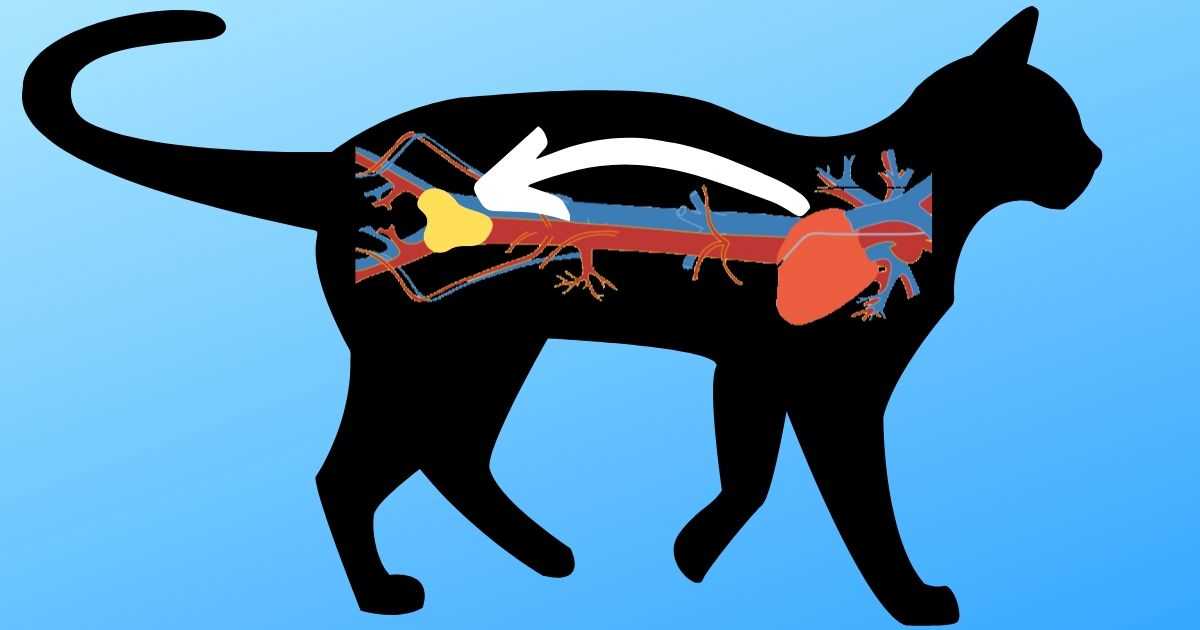Updated March 26, 2021
I was a young vet only a few months out of university when I saw my first aortic or arterial thromboembolism (ATE). This is a horrible disease of cats caused by a saddle thrombus: a blood clot released from the heart that is ejected down the aorta and blocks it near the hind legs.
These cats are in severe distress from having cold, hard, painful hind legs and pulmonary oedema. They also often have pre-existing heart disease.
The first cat I saw, I treated as I’d been taught and he made a rapid and full recovery. As far as I know he went on to live a good life.
The problem is that this experience was an outlier, only I didn’t know it. It meant that for many years afterwards I’d see other cats with ATE give their owners a positive outlook and attempt to treat them.
I say ‘attempt’, because they always did badly, even though I used the same treatment. There’s almost nothing worse for a vet than trying to treat a suffering patient only to realise three days later you should never have put them through it. We want to avoid that at all costs.
My mistake was prioritising my personal experience over the science. Here’s what it says:
Treatment of Aortic Thromboembolism In Cats
Four large studies look at success rates for the treatment of cats with ATE
- 33% survival with a medial survival time of 51 days (46 cats)
- 37% survival with a medial survival time of 11 months (100 cats)
- 39% survival with a median survival time of 6 months (44 cats)
- 31% survival with a medial survival time of 4 months (127 cats)
In looking at these results, we have to keep in mind two things. Firstly, these cats were treated in 24 hour intensive care referral centres, not private clinics. Secondly, how important it is to look at long-term survival data, not just how many get out of hospital.
Now you know that these terrible rates of success exist despite the best of care, you will hopefully see why I now only offer two options to cat owners facing ATE:
- Emergency referral to a specialist centre, with a clear warning of the poor prognosis
- Humane euthanasia
In my opinion, given the suffering, anything else is inhumane. This is just my view, and if your vet feels differently, I cannot argue. It’s a judgement call.
Though I suspect I am not alone, judging by a recent paper. Of 250 cats with ATE seen in general practice, the decision between vets and owners was euthanasia for 153 of these. When you look at the rest you can see why: only 30 of the remaining cats were still alive one week later, and their median survival time was only 3 months.
But if you’re reading this because your cat’s unwell, don’t give up yet. ATE is not the only cause of a cat’s back legs suddenly not working, or dragging the back legs. Get to your vet ASAP and get a proper diagnosis before making any decision.
So what about the positive information you read on online forums?
The Outlier Effect

When you search online about your dog’s or cat’s illness, you’ll quickly find forums, full of well-meaning advice. Some of it is undoubtedly useful; after all, these are real experiences from pet owners sharing what you’re going through.
However, some is extremely misleading. The outlier doesn’t know they’re an outlier, and even I was guilty of that despite knowing better. Outliers are also more likely to be the ones wanting to share their experiences, whether good or bad.
I use forums too. I find them especially useful when I want to know if something has ever happened, or if anyone has reported the thing I’m seeing. What I’ll never do without checking is use any advice I see, whether on treatment or prognosis. For this we need science.
Blimey, I won’t even use case reports, which are published accounts of a single case. I need to see good outcome data, enough to make an informed decision. I certainly don’t need unrealistic expectations at this most critical time.
In the case of diseases like aortic thromboembolism, using anything except good science is likely to lead to false hope and bad decisions like mine. I’ve learnt my lesson, but if it was so hard for me I can understand why it’s even harder for cat owners.
Have something to add? Comments (if open) will appear within 24 hours.
By Andrew Spanner BVSc(Hons) MVetStud, a vet in Adelaide, Australia. Meet his team here.
Further Reading
Borgeat, K., Wright, J., Garrod, O., Payne, J. R., & Fuentes, V. L. (2014). Arterial thromboembolism in 250 cats in general practice: 2004–2012. Journal of veterinary internal medicine, 28(1), 102-108
Moore, K. E., Morris, N., Dhupa, N., Murtaugh, R. J., & Rush, J. E. (2000). Retrospective study of streptokinase administration in 46 cats with arterial thromboembolism. Journal of Veterinary Emergency and Critical Care, 10(4), 245-257
Laste, N. J., Harpster, N. K., Harkins, J. D., Stanley, S., Mundy, G. D., Sams, R. A., … & McAllister, P. M. (1995). 2392581. A retrospective study of 100 cases of feline distal aortic thromboembolism: 1977-1993. Journal of the American Animal Hospital Association, 31(6), 492-500
Schoeman, J. P. (1999). Feline distal aortic thromboembolism: a review of 44 cases (1990–1998). Journal of Feline Medicine & Surgery, 1(4), 221-231
Smith, S. A., Tobias, A. H., Jacob, K. A., Fine, D. M., & Grumbles, P. L. (2003). Arterial thromboembolism in cats: acute crisis in 127 cases (1992–2001) and long‐term management with low‐dose aspirin in 24 cases. Journal of veterinary internal medicine, 17(1), 73-83


I am in the same situation but in stead i can not forgive myself that i took the decision of euthanasia for my cat. Also thank you doctor for sharing this to us , knowing that a vet doctor thinks like that i hope after time i will feel better or relief
“In the case of diseases like aortic thromboembolism, using anything except good science is likely to lead to false hope and bad decisions like mine.”
This makes so much sense, I’m going through this right now with my own cat and I appreciate this article more than you’ll ever know. Thanks so much for sharing your experience Im sure it will help a lot of readers.
My middle age male cat has all the symptoms but no pain. He is my second cat diagnosed with saddle thrombus but he also had no pain and lived six months. Does the absence of pain indicate another cause for full paralysis of the hind legs?
Hi Suzanne. This condition cannot be diagnosed at home and it is very likely that your cat has another (treatable) condition. Please see a vet as soon as possible.
Thank you for this article. Went through this with my cat about 18 months ago. Sudden onset, extreme pain, paralysis of both hind legs. At first I though she had damaged her back leaping onto something, until I realised her hind paws were quite cold. Then I knew it was something much more sinister. Took her straight to the vet where she was quickly diagnosed and sadly, but humanely euthanised. It was an awful experience as she was obviously in a lot of pain and there was nothing I could do to help her. Very nasty condition, and if your pet show any of these signs get them to the vet ASAP.